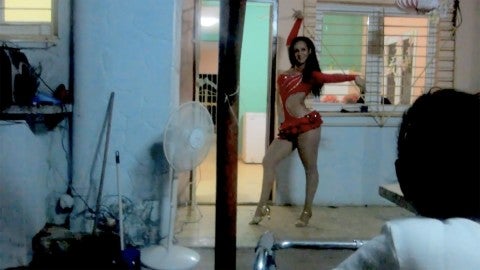Video is just one of the ways in which artist Alejandro Figueredo Díaz-Perera expresses himself. As a conceptual artist, he works in various mediums—photography, painting, installation, text, and video. According to him, “the medium is dictated by the idea or investigation.” Thus, in works such as Skin (2014), Díaz-Perera related skin to the built environment by layering up to thirty coats of latex paint onto a drywall surface and then cutting into and manipulating the layers to reveal new, complex geometries. This original focus on drawing and sculpture later gravitated to video and installation. As he explains, “I always see myself as making experiments and taking risks…. I felt that at [a] point video would give me the chance to move forward.”
Dissonance (2015), for instance, is a two-channel video for which the monitor is placed near the floor, thus requiring viewers to kneel down. In doing so, their position replicates that of political prisoners, such as the ones seen in an execution image from the Spanish American War hung in the gallery. The video contains audio from Assata Shakur, a member of the former Black Liberation Army and now a U.S. refugee living in Cuba, reading an open letter to the Pope that details how she was targeted and wrongly imprisoned by the U.S. government. The piece also features a recording of a phone call by Cuban-born performance artist Tania Bruguera to her sister after she was arrested for an attempt to place a microphone in Havana’s Revolution Square for Cubans to speak their minds in public. As viewers listen to the women defend themselves, they are meant to feel their vulnerability and oppression, both physically and emotionally.
Also partly in response to Bruguera’s predicament, Díaz-Perera created The Silence (…) is Overrated (2014). A microphone is rigged to rub, bang, and scratch itself against the gallery wall until it perhaps breaks. The dissonant sound it emits becomes symbolic of Bruguera’s and other Cubans’ (such as Díaz-Perera’s) struggles for free expression against governmental suppression of their voices. Moreover, as the microphone is suspended in the air, it suggests the would-be speakers are in limbo. In the Absence of a Body (2017) would further explore this concept, with Díaz-Perera being simultaneously absent and present.
He created a liminal space behind the wall of a gallery, literally a 2.5-feet-wide by 10-feet-long crawl space. For the three-week run of his solo exhibition, Díaz-Perera took a vow of silence; lived with a few clothes, a mat, a pillow, a blanket, a lamp, and a hammer (in case of an emergency); and received meals through a vent. Visitors could hear him breathing or his soft footsteps at times, which called attention to what was not present: Díaz-Perera’s body and voice. Unable to return to Cuba as he waits to obtain his permanent residency in the United States through the Cuban Adjustment Act, Díaz-Perera’s absence alludes to his separation from his family and in general the difficulty of interaction and communication between Cuba and America.
In addition to his solo practice, Díaz-Perera is part of the collaborative Díaz Lewis with his partner, Cara Megan Lewis. Lewis and Díaz-Perera met during the Havana Biennial in 2012. They kept in contact, sending expensive text messages to each other, which resulted in a published book of their correspondence. Social practice would continue to inform their later projects, such as 34,000 Pillows (2016–present), created in observance of International Human Rights Day. Díaz Lewis invited guests to sew pillows for every bed occupied at U.S. detention facilities as a way to highlight a mandate for immigration agencies to maintain a “bed quota” of 34,000 detained immigrants per day. The “ongoing project will continue until we reach 34000 pillow sales to fundraise for non-profit organizations that help and support immigrant communities in the USA. The total of these sales is equivalent to the same amount that our Gov. spends daily in private prison companies to arrest and jail immigrants in this country.”
Díaz-Perera’s video Love is a Rebellious Bird (2017), thus might seem like an anomaly. It is a single-channel video collage that references cultural appropriation through the utilization of YouTube videos published by Cuban users. The edited videos are accompanied by African, Caribbean and operatic musical scores which have been reworked and recontextualized. These include “Habanera,” the famous aria in George Bizet’s opera Carmen, from which the video’s title comes. The term habanera also can be translated as “the dance of Havana,” and fittingly, nearly all the clips in the compilation feature people dancing in fun, flirty, or suggestive ways.
Moreover, the ages of the subjects grow progressively older in each scene. The video begins with a baby in a diaper and advances to small children, teenagers, young adults, and finally middle age and elderly people dancing at parties and in the streets. While the subjects might appear to be engaged in frivolous activities, their dances represent a sense of freedom that even the Cuban government cannot suppress (or restrict from the internet). Díaz-Perera has stated, “I want to understand my own contradictions and the contradictions of a generation.” However, in Love is a Rebellious Bird he demonstrates similarities and continuities across generations, particularly the desire to express oneself and the will to find a way, if not through the voice or text, then through the body and music. —Kanitra Fletcher

